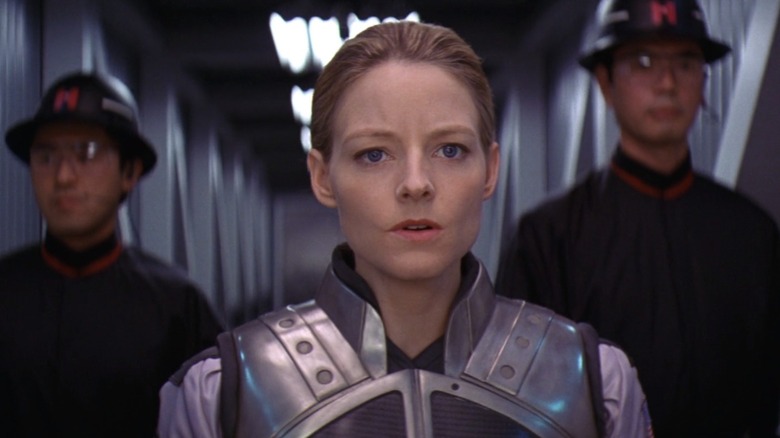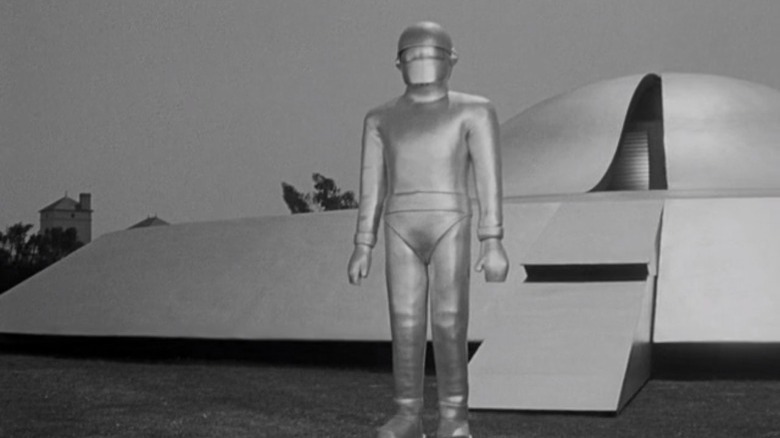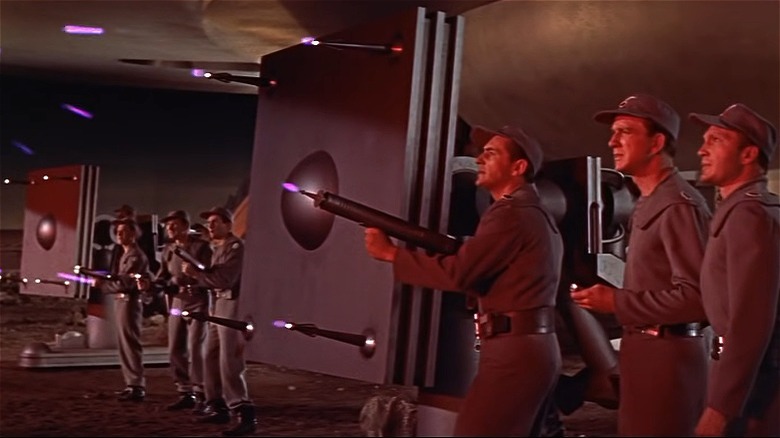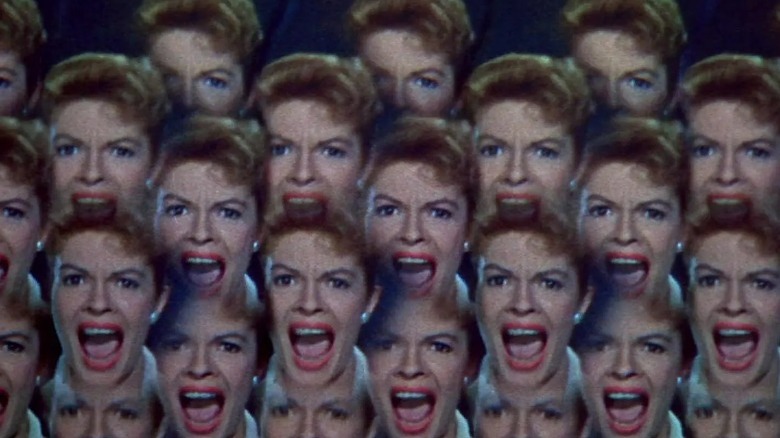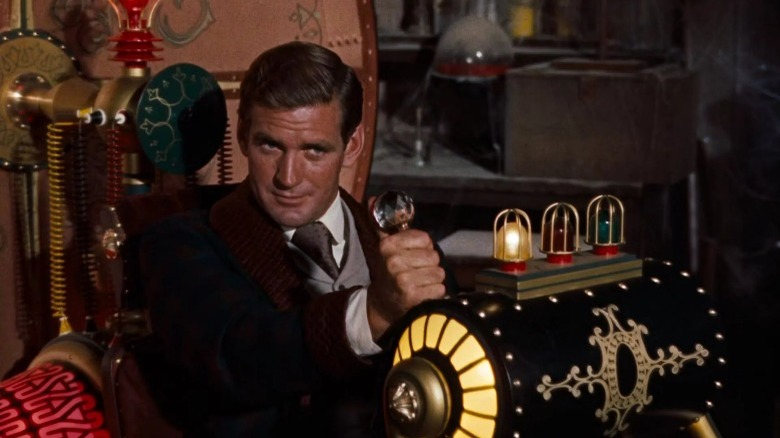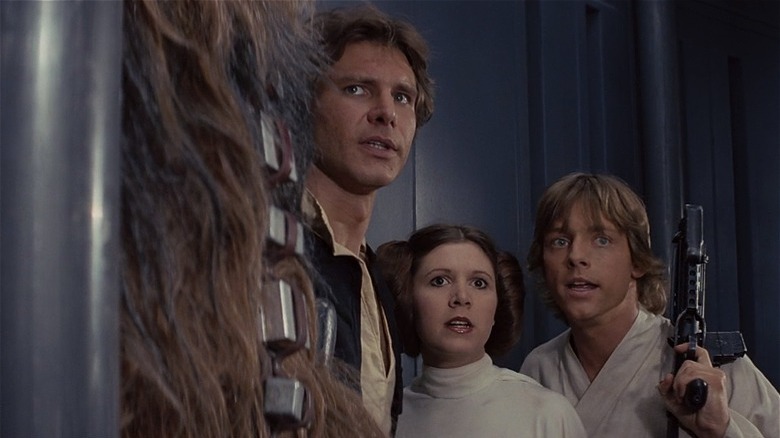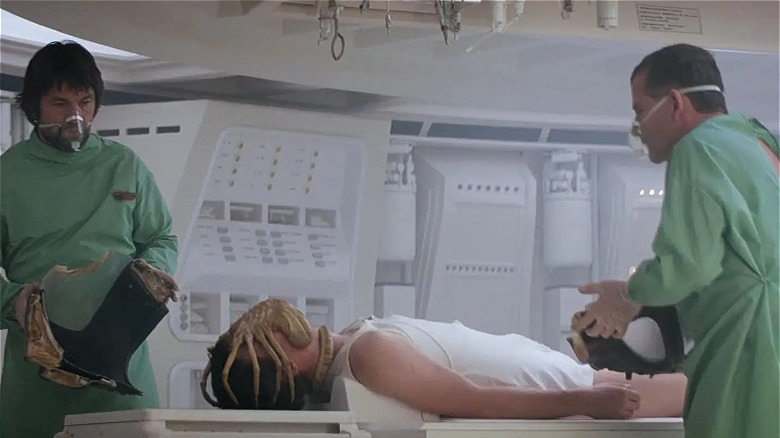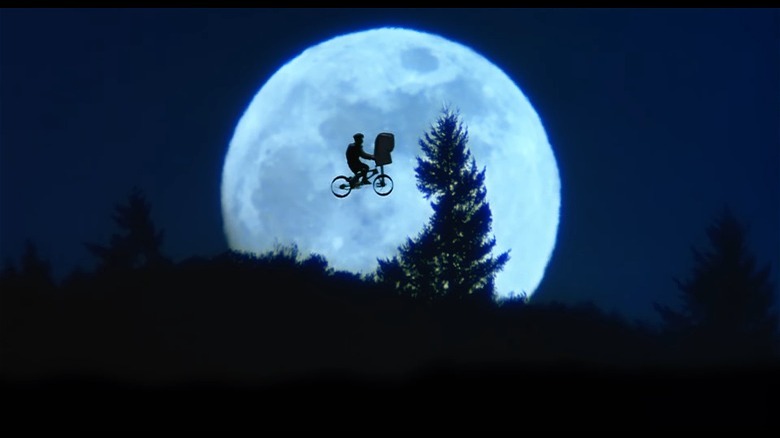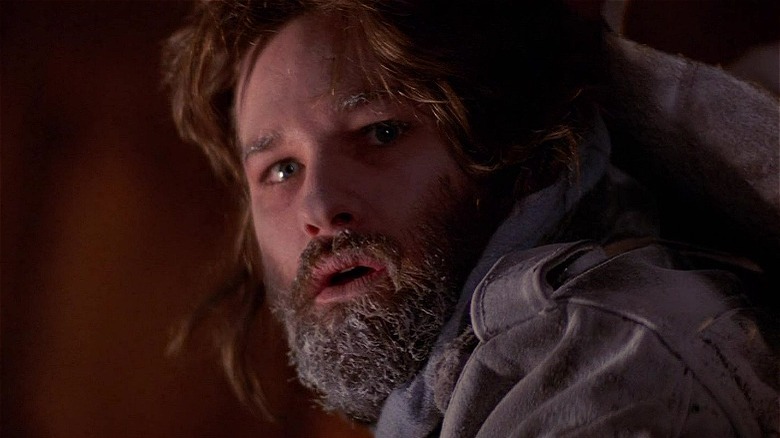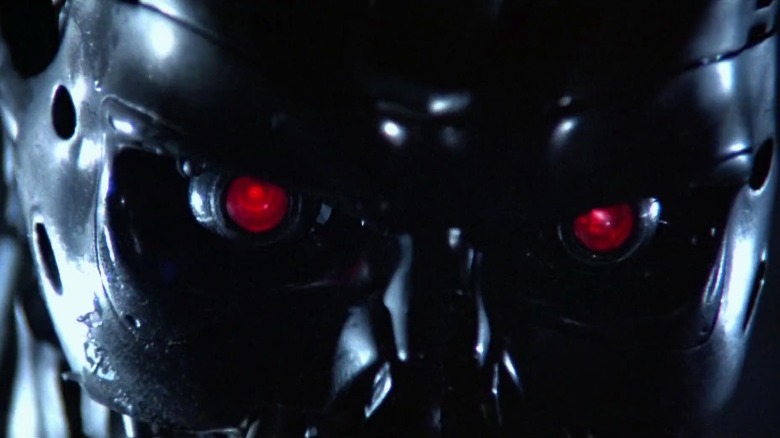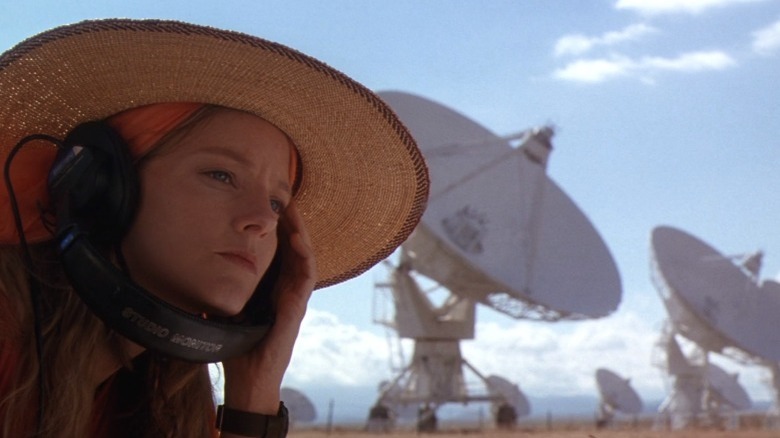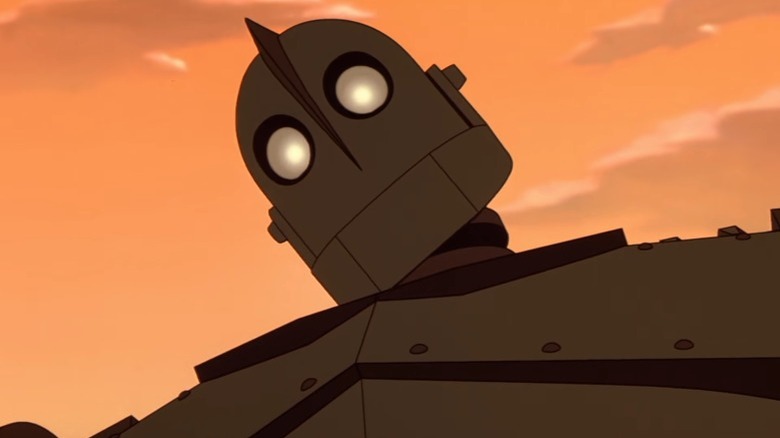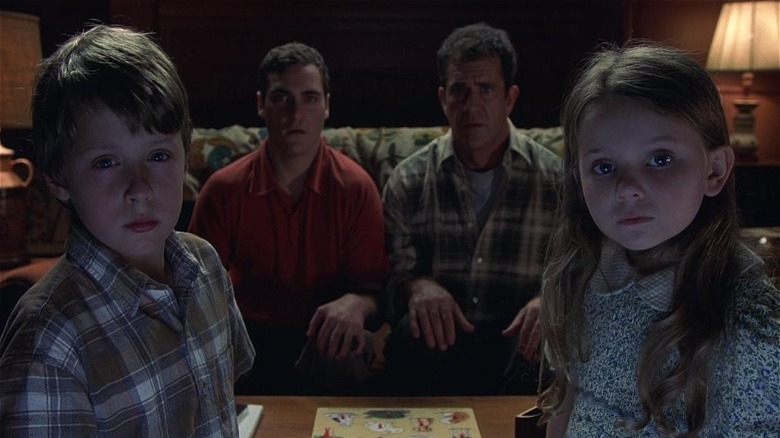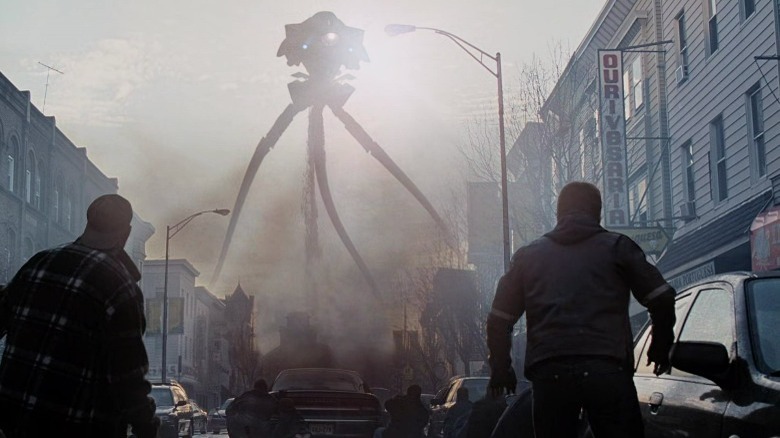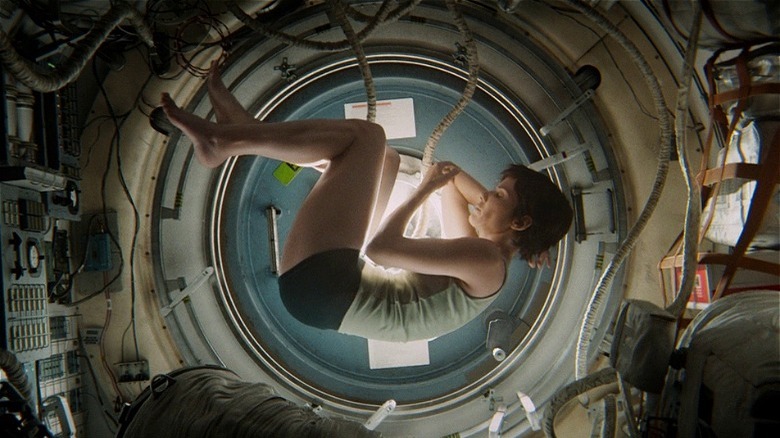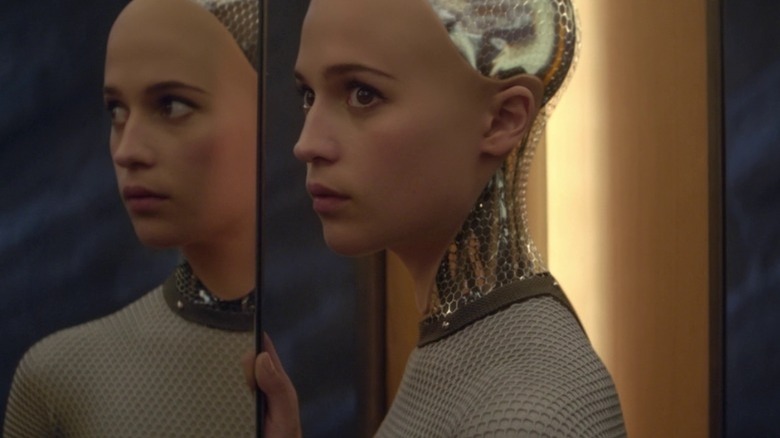The Best Sci-Fi Movies To Watch If You're New To The Genre
Newcomers to science fiction might not know where to start diving into this strange and fantastical genre — or even if it's worth the ride. But, good news! Sci-fi is incredibly versatile, containing elements and expectations that fit into several subgenres like action, horror, romances, and even comedies.
The World Fantasy award-winning Ray Bradbury once told The New York Times (via Reuters), "In science fiction, we dream." Sure, the genre allows writers, filmmakers, and viewers to imagine far-flung, fantastical worlds and creatures. But it's also a clever way to comment on humanity. Bradbury also said, "Science fiction is also a great way to pretend you are writing about the future when in reality you are attacking the recent past and the present." Sci-fi asks questions like: What might the world be like if we all suddenly learned that we are part of something larger?
Here's a chronological list of landmark films that further developed the genre. Some recommendations are old, and some are newer crowd-pleasing blockbusters. Nevertheless, these films contain critical cultural phenomena that are worth exploring. For those new to sci-fi films, these are the best films to watch.
The Day the Earth Stood Still (1951)
Debuting in 1902, Georges Méliès' "A Trip to the Moon" was one of the world's first fictional films. Méliès' work is science fiction, depicting a rocket full of explorers traveling to the moon. Back then, traveling to the moon was a fantastical idea.
A few decades later, following two World Wars and amidst the Cold War, the sci-fi genre saw a resurgence in popularity in the '50s. Space exploration wasn't the only subgenre: people feared outsiders landing on their shores. Enter: "The Day the Earth Stood Still," a black and white alien-invasion film from 1951. On the surface level, the Robert Wise film is a romp about an alien traveling to Earth to understand humanity, filled with a robot, laser guns, and some cheesy (yet charming) practical effects. Looking deeper, "The Day the Earth Stood Still" is a cautionary tale. Klaatu (Michael Rennie), a man from another planet, wants to send a message to all of Earth's political leaders at once. Of course, Earth's international relations get in the way, showcasing how humanity's inability to get along with each other prevents them from receiving a message of enlightenment.
In other words, the best sci-fi films are not just stories of distant worlds and alien races. They're stories that lean into sci-fi's political potential to teach viewers about their world.
Forbidden Planet (1956)
In the 1950s, studios cranked out dozens of sci-fi pictures that felt interchangeable. Some, though, have managed to stand the test of time — like the formidable "Forbidden Planet." Now, it looks kitschy — as if painted plywood made up most of the set design. But for the time, it had a groundbreaking $2 million budget. But it's also got some fantastic matte-painted backdrops. Plus, it's simmering with pop psychology: This movie is what coined the often-quoted phrase "monsters from the id." Also, it's even a loose retelling of Shakespeare's "The Tempest."
In "Forbidden Planet," a crew of space-explorers land on Altair IV. They meet a mysterious doctor named Dr. Morbius — no relation to Marvel's superhero vampire — and his beautiful daughter Altaira. Frightening, invisible creatures patrol the desert, surrounding the doctor and his daughter. Notably, this film has one of cinema's most iconic robots: Robby the Robot. Since his 1956 debut, Robby has appeared in dozens of movies and television shows — ranging from "The Twilight Zone" to "Looney Tunes: Back in Action" — earning him the title of "the hardest-working robot in Hollywood" from film scholars. That character even has an IMDb profile. However, Robby the Robot's first outing is his most enduring work. This is a must-see for anyone looking to dip their toes into sci-fi.
The Fly (1958)
Science fiction increased in popularity during the atomic age, bringing darker, scarier messages to the big screen. Following the invention of the nuclear bomb, the central thrust of science fiction was no longer about the exciting potential of knowledge. Instead, humanity realized science could create a world-ending power. In this era, filmmakers frequently told stories about laboratory tinkerers whose pursuit of invention went too far — like 1954's "Them!"
Kurt Neumann's 1958 film "The Fly" fits neatly into this subgenre of atomic-age-mad-scientist movies. "The Fly" follows scientist Andre Delambre's (David Hedison) invention of the teleportation machine. Unfortunately, a malfunction leads to his molecules becoming mixed with those of a fly, creating a monstrous creature. His wife Helene (Patricia Owens) and his brother François (the iconic Vincent Price) are desperate to end his suffering and prevent him from furthering his harmful science.
Neumann's film had an immense effect on popular culture. The film's haunting ending has been parodied and referenced in pop culture endlessly. David Cronenberg remade "The Fly" in the '80s as a grotesque exercise in body horror. Cronenberg's film is also a masterpiece, but audiences shouldn't overlook that the original stands the test of time. Essentially, the film is an effectively told morality tale about the dangers and necessity of scientific pursuit.
The Time Machine (1960)
H.G. Wells is responsible for many of sci-fi's most enduring and archetypal stories. One of his most famous novels is "The Time Machine," which tells the story of a man who invents the ability to time travel to learn what will become of humanity. George Pal's 1960 film adaptation is a solid and accessible film for anyone looking to get a sense of earlier entries in the sci-fi genre. The Metrocolor cinematography is stunning, and the time travel sequences feature impressive stop-motion sequences. Rod Taylor's performance is charming (people should talk more about what a dashing leading man he was).
When Wells wrote his book in 1895, he couldn't have anticipated the World Wars that would befall Europe in the following decades. Fittingly, Pal's film sets its story in London at the turn of the century, but it has the benefit of looking slyly back in time as its hero goes forward. Unlike the 19th-century novel, the film adaptation delivers commentary on the horror of the Blitz and the lingering, existential threat of nuclear devastation. When the time traveler lands in the future, he finds a society that has split in two. The peaceful and obedient Eloi live aboveground, enslaved to the cannibalistic Morlocks in fallout shelters. Overall, it's an excellent example of science fiction's ability to speak to the future and present at once.
Star Wars: A New Hope (1977)
It's impossible to discuss science-fiction cinema without mentioning George Lucas' "Star Wars – A New Hope." For many sci-fi fans, this was their gateway into outer space storytelling. Although the franchise has come to dominate pop culture in a way that might be outsized, Lucas' original film trilogy is still worth watching for anyone who wants to know what this sci-fi stuff is all about.
Even if someone hasn't seen the original film, they likely know its broad outlines — thanks to the ever-expanding "Star Wars" franchise. "A New Hope" follows a classic space-opera formula: There's a captured princess, a hero's quest, memorable aliens, and space wizards. The 1977 film debuted one of cinema's most iconic villains, Darth Vader (portrayed by David Prowse and voiced by James Earl Jones).
Before The Imperial forces capture her, the determined Princess Leia (Carrie Fisher) tells her droid R2D2 (Kenny Baker) to find Obi-Wan Kenobi (Alec Guinness). Harrison Ford plays the swashbuckling adventurer Han Solo, seeking to save Leia. Luke Skywalker (Mark Hamill), a mysterious farmhand destined to save the galaxy, joins his quest. Also, the film introduced lightsabers into pop culture.
While it's easy to be resistant to watching this film — due to the franchise's dominance in mainstream television and film — it's also fun to give in to the fantasy and childlike sense of wonder it has. As "Star Trek: The Next Generation" (a sci-fi television show that's also worth a watch) put it best: "Resistance is futile."
Alien (1979)
Sci-fi continues to thrive thanks to the genre's versatility. Filmmakers can graft the genre's hallmarks onto any number of stories. One of the best examples of this range is Ridley Scott's 1979 masterpiece, "Alien." Scott blends horror's creature features and haunted house subgenres into an elegant sci-fi film.
In "Alien," a crew works aboard the Nostromo, a working-class, rundown freighter in the deep recesses of space. The team comes across a distress signal on a nearby planet, and a scientist's carelessness leads to an aggressive alien boarding the ship. There are gross-out setpieces and heart-stopping chase sequences, which build to an all-out assault on the senses in the movie's final act. The alien's implantation method calls upon the audience's fear of rape: It's no accident that the Xenomorph's gross head looks awfully phallic.
To its credit, "Alien" is a feminist classic. Sigourney Weaver's Ripley is one of cinema's most enduring heroes. Her androgyny makes her all the more compelling as she's able to shift seamlessly between nurturing qualities and more traditionally masculine ones like battling aliens. The crew even calls the computer that controls the ship "Mother." Like "Star Wars," this is a foundational text for so much sci-fi that came after, making it a must-watch film.
If you or anyone you know has been a victim of sexual assault, help is available. Visit the Rape, Abuse & Incest National Network website or contact RAINN's National Helpline at 1-800-656-HOPE (4673).
E.T. the Extra-Terrestrial (1982)
"E.T. the Extra-Terrestrial" is Steven Spielberg's second family-friendly science fiction film, following the equally excellent "Close Encounters of the Third Kind." His 1982 film explores what audiences now know as a classic sci-fi setup: boy-meets-alien, boy and alien become friends, and then the mean old government tries to steal the alien. There are bike rides through the sky, iconic lines of dialogue, and an adorable Halloween sequence — complete with a nod to a little film called "Star Wars – A New Hope," directed by Spielberg's friend George Lucas.
When fans talk about a Spielbergian sense of wonder and awe, this is the film that best embodies that concept. Even the most cynical viewers will be won over by its charms. It helps that "E.T." is grounded by a pair of fantastic child performances — Henry Thomas' Elliott and a young Drew Barrymore's Gertie. Thomas was so good during his audition that he landed the role on the spot. "E.T." taught a generation that aliens didn't have to be scary. If people could learn to see the universe through Elliott and E.T.'s kind eyes, humanity might be better off.
The Thing (1982)
"E.T." proved aliens didn't have to be scary, but two weeks later, an altogether different vision of aliens hit cinemas — John Carpenter's "The Thing." The Carpenter classic takes place at a research station in Antarctica and follows a group of scientists investigating the burned-out remains of another station. Something horrific seems to have taken place, so the men investigate further. Over the course of the film, they realize there's a thing among them, a creature from another world who can shapeshift, and it's hiding amongst them. Paranoia spirals out of control, becoming a nearly unbearable, wild ride.
"The Thing" is a chilling film that makes excellent use of its frigid setting: Earth seems like a foreign planet. Rob Bottin's practical VFX effects on "The Thing" are horrific, and they have aged extremely well — unlike the CGI effects in the (still solid) 2011 prequel of the same name. 1982's "The Thing" boasts an all-star cast, including Kurt Russell, Keith David, and Wilford Brimley. Each cast member gives an excellent performance, expertly conveying the terror of their situation. Incredibly, "The Thing" flopped when it debuted in theaters, with The New York Times calling it "instant junk" (via Den Of Geek). Critics then were so wrong.
The Terminator (1984)
If "Alien" is a haunted house film, then James Cameron's "The Terminator" is a slasher, proving that sci-fi can do anything. Cameron based "The Terminator" on a nightmare he had, centering the film on a killer robot, The Terminator (Arnold Schwarzenegger). The robot is sent back in time to kill a woman named Sarah Connor (Linda Hamilton) before she gives birth to the man who will save humanity during the robot wars. However, the robot doesn't count on the human Kyle Reese (Michael Biehn) traveling back in time to protect her. As the robot slices its way across Los Angeles, Sarah and Kyle try to outrun the terrifying killing machine.
Later films in the "Terminator" franchise lean harder into action, but the original one is all about atmosphere. Throughout its 107-minute runtime, the film is creepy and intense, gleefully courting questions around time-travel paradoxes. However, it's also a romance! Hamilton and Biehn are a delight to watch. Those who enjoy watching people fall in love while the world falls apart around them will adore "The Terminator."
Contact (1997)
Whether or not humans are alone in the universe is one of science fiction's foundational mysteries. "Contact," Robert Zemeckis' ponderous 1997 film, attempts to answer this question that's been around since human existence and the formation of religion. The 1997 film follows a woman as she discovers a signal from space that might be humanity's first evidence of aliens.
The film is a talkative one, very heady, but not, by any means, inaccessible. "Contact" clearly lays out its arguments in favor of science and faith — suggesting that there's a power (rather than conflict) in the idea that both approach a similar essential truth from different angles. Jodie Foster's Eleanor Arroway is a scientist, while Matthew McConaughey's Palmer Joss (in full-sensitive-'90s-hunk mode) plays a man of faith. Together, they complement rather than detract from each other's approach.
The biggest flaw in "Contact" might be that it bites off more than it can chew — thematically and structurally. However, its optimistic messiness is part of its beauty. Foster's bravura Ellie, a woman dedicated to advancing humanity's place among the stars, holds the film together through sheer force of will. Without spoiling whether or not Ellie succeeds in convincing humanity to set aside our differences and believe in something greater than ourselves, it's fair to say that it sure is rewarding to watch her try.
The Iron Giant (1999)
"The Iron Giant" is a heartwarming, family-friendly sci-fi outing in the vein of "ET." It's about a boy who discovers an alien — this time, a giant robot (Vin Diesel). The audience watches as Hogarth Hughes (Eli Marienthal) learns to communicate with it before the government messes everything up. Director Brad Bird tells the story through a gorgeous mix of hand-drawn animation and CGI, wrapped in a '50s atomic-age setting that plays into the history of sci-fi adventure stories. (Check out that tagline on the film's original movie poster, which references a classic '50s alien invasion flick). In short, it's a delight.
Surprisingly, "The Iron Giant" has mature themes. This robot isn't there to look cool or provide a form of wish-fulfillment for preteen boys. In one of the film's most touching sequences, the Iron Giant learns about death and contemplates the existence of its soul. Thanks to Diesel's tender voiceover work, it's a stunning moment — taking place decades before he found a thousand different vocal inflections for the Marvel Cinematic Universe's Groot. His Giant's speech patterns are halting and don't sound human — after all, Diesel's normal speaking voice sounds like sheets of metal scraped over gravel. But his character nevertheless aches with an all-too-recognizable yearning to be known and loved. That's the empathetic power of science fiction, and "The Iron Giant" is one of the best.
Signs (2002)
It's incredible to realize that M. Night Shyamalan's "Signs" was in production amidst the terrorist attacks of September 11, 2001. The film feels steeped in Bush-era anxieties around shocking, world-changing events consumed primarily as a media spectacle. Though the arrival of extraterrestrials is playing out quite literally in their backyard — in the form of crop circles in cornfields — Mel Gibson's Graham Hess and his family spend the film glued to their televisions, breathlessly watching news broadcasts of a worldwide invasion.
Wisely, Shyamalan's film strips its sci-fi story down to its essential elements. The film takes place on an all-American farm run by a former preacher, his two young children, and his brother. "Signs" features very few mega-budget special effects. Instead, until its horrific climax, "Signs" finds scares in shadows glimpsed through nighttime cornfields and otherworldly beings captured in grainy film footage. Powered by themes of religious guilt, "Signs" becomes a story about the power of symbols and prayer.
"I think part of the spirituality of the movie came from its time, where we were at that moment," Shyamalan told The Ringer in 2020. "All of us felt vulnerable and grateful to be together... feeling lucky on a lot of levels." That message shines through in his film. This is a movie that uses its sci-fi trappings to tell a story about family. It's as if the film is saying: If this is the end, then at least we're together.
War of the Worlds (2005)
Some sci-fi stories resonate so much that they gain countless adaptations, passing as something close to myth. H.G. Wells' seminal novel "The War of the Worlds" is one such tale. Orson Welles' infamous 1938 radio play of the same name was so good that it convinced listeners that it was a real-life alien invasion. In 1953, a decent film adaptation hit theaters. However, Steven Spielberg's 2005 adaptation may be the seminal incarnation of the story on film. To its credit, it's one of the most widely accessible sci-fi films to audiences largely unfamiliar with the genre.
Like "Signs," Steven Spielberg's "War of the Worlds" is a post-9/11 film that explores Americans' fear of foreign invaders. However, unlike the pared-down "Signs," Spielberg goes for maximalist invasion mayhem. Through-and-through, this is an action movie. Early sequences show the street-level chaos of the attack and the horror of a city-wide destruction event. As the Tripods reduce buildings to billowing clouds of dust and debris, it reminds viewers of real-life terrorist attacks on New York City.
Tom Cruise anchors the film as Ray Ferrier, a single father raising his children: Robbie (Justin Chatwin) and Rachel (Dakota Fanning). At the heart of this film is a family story. Ferrier's increasing desperation to get his family away from the Tripods is perhaps its most successful element. A wild ride from start to finish, "War of the Worlds" is one of Cruise's best performances and one of Spielberg's best films.
Gravity (2013)
A lot of sci-fi movies try to look like they were filmed in space, but no film has come as close as Alfonso Cuarón's "Gravity." Featuring a career-best performance by Sandra Bullock as Ryan Stone, "Gravity" follows a scientist trying to fix the Hubble Telescope. In a stunning long take — that lasts an astounding seventeen minutes — a transmission from Houston informs Dr. Stone and her colleague Matt Kowalski (George Clooney) that a satellite explosion has caused a chain reaction. Unfortunately, a cloud of debris is incoming. Before they can return to the safety of the shuttle, the debris hits. Ryan is sent spinning, untethered through the dark reaches of space. "Dr. Stone is off-structure and drifting," Kowalski's voice crackles over the radio. It's one of the most chilling lines in all of sci-fi cinema.
As its title suggests, the film feels like a force of nature. In some ways, "Gravity" is about storytelling. Kowalski often bores his colleagues with long, rambling tales of his life back on Earth. This is a history-altering event, and the images Cuarón uses to tell his story carry the weight of myth: a cluster of lights along a shadowy coast, or an astronaut curled in the fetal position. As Dr. Stone tries to return to Earth, she realizes that if she survives, she'll have "one hell of a story to tell." And, "Gravity" sure is one hell of a film.
Ex Machina (2014)
In today's age of tech billionaires, much of our news-cycle conversation around scientific achievement centers on figures like Elon Musk — controversial mega-corp CEOs who pour money into the advancement of technology, in part, to convince themselves that they're helping others. Alex Garland's "Ex Machina" dives into this culture, bridging the gap between the Silicon Valley wave of app entrepreneurs and cult-of-personality tech eccentrics. "Ex Machina" has a lot to say about all of the above.
Garland's film uses the Turing Test as its central conceit — the idea that artificial intelligence will have achieved sentience when it can convince a human that it is conscious. In this movie, a programmer named Caleb (Domhnall Gleeson) wins a visit to the remote home of his company's charismatic CEO, Nathan (Oscar Isaac). After his arrival, he's asked to administer a Turing Test on the CEO's new AIs. In other words, "Ex Machina" is a small story with massive implications, like many of the best sci-fi films.
"Ex Machina" centers around four characters — two humans and two robots — played by four fantastic actors at the beginning of their fame. Isaac, Gleeson, Alicia Vikander, and Sonoya Mizuno excel at playing off one another. The film's single setting adds a claustrophobic pressure that gradually becomes explosive. Characters spiral out of control as the massive weight of what they're doing hits them, and it's fascinating to witness their realizations unfold.
